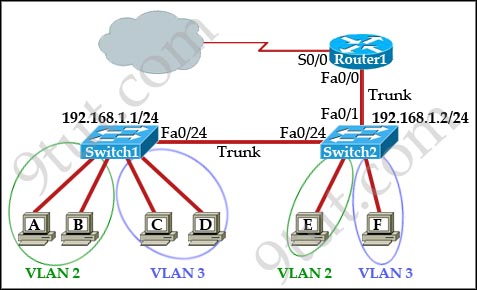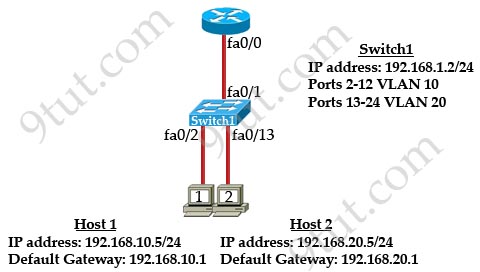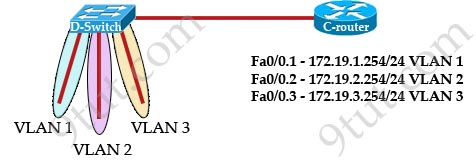ICND2 – InterVLAN Routing
[am4show have=’p2;’]
Premium Member: You can test your knowledge with these questions first via this link.
[/am4show]
If you are not sure about InterVLAN routing, please read my InterVLAN Routing Tutorial (Premium Tutorial)
Question 1
[am4show have=’p2;’]Refer to the exhibit:

Which two statements are true about interVLAN routing in the topology that is shown in the exhibit? (Choose two)
A. Host E and host F use the same IP gateway address.
B. Routed and Switch2 should be connected via a crossover cable.
C. Router1 will not play a role in communications between host A and host D.
D. The FastEthernet 0/0 interface on Router1 must be configured with subinterfaces.
E. Router1 needs more LAN interfaces to accommodate the VLANs that are shown in the exhibit.
F. The FastEthernet 0/0 interface on Router1 and Switch2 trunk ports must be configured using the same encapsulation type.
Answer: D F[/am4show]
Question 2
[am4show have=’p2;’]Refer to the exhibit:

What commands must be configured on the 2950 switch and the router to allow communication between host 1 and host 2? (Choose two)
A. Router(config)#interface fastethernet 0/0
Router(config-if)#ip address 192.168.1.1 255.255.255.0
Router(config-if)#no shut down
B. Router(config)#interface fastethernet 0/0
Router(config-if)#no shutdown
Router(config)#interface fastethernet 0/0.1
Router(config-subif)#encapsulation dot1q 10
Router(config-subif)#ip address 192.168.10.1 255.255.255.0
Router(config-subif)#interface fastethernet 0/0.2
Router(config-subif)#encapsulation dot1q 20
Router(config-subif)#ip address 192.168.20.1 255.255.255.0
C. Router (config)#router eigrp 100
Router(config-router)#network 192.168.10.0
Router(config-router)#network 192.168.20.0
D. Switch1(config)# vlan database
Switch1(config-vlan)# vtp domain XYZ
Switch1(config-vlan)# vtp server
E. Switch1(config)# interface fastEthernet 0/1
Switch1(config-if)# switchport mode trunk
F. Switch1(config)# interface vlan 1
Switch1(config-if)# ip default-gateway 192.168.1.1
Answer: B E[/am4show]
Explanation
The two answers B and E list all the commands needed to configure interVLAN routing. Please notice that Cisco switch 2950, 2960 only support dot1Q trunking so we don’t need to specify which trunking encapsulation to use in this case. For Cisco switches 3550 or above we have to use these commands instead:
Switch3550(config-if)#switchport trunk encapsulation dot1q
Switch3550(config-if)#switchport mode trunk
Question 3
[am4show have=’p2;’]Which three statements are typical characteristics of VLAN arrangements? (Choose three)
A. A new switch has no VLANs configured.
B. Connectivity between VLANs requires a Layer 3 device.
C. VLANs typically decrease the number of collision domains.
D. Each VLAN uses a separate address space.
E. A switch maintains a separate bridging table for each VLAN.
F. VLANs cannot span multiple switches.
Answer: B D E[/am4show]
Explanation
By default, all ports on a new switch belong to VLAN 1 (default & native VLAN). There are also some well-known VLANs (for example: VLAN 1002 for fddi-default; VLAN 1003 for token-ring…) configured by default -> A is not correct.
To communicate between two different VLANs we need to use a Layer 3 device like router or Layer 3 switch -> B is correct.
VLANs don’t affect the number of collision domains, they are the same -> C is not correct. Typically, VLANs increase the number of broadcast domains.
We must use a different network (or sub-network) for each VLAN. For example we can use 192.168.1.0/24 for VLAN 1, 192.168.2.0/24 for VLAN 2 -> D is correct.
A switch maintains a separate bridging table for each VLAN so that it can send frame to ports on the same VLAN only. For example, if a PC in VLAN 2 sends a frame then the switch look-ups its bridging table and only sends frame out of its ports which belong to VLAN 2 (it also sends this frame on trunk ports) -> E is correct.
We can use multiple switches to expand VLAN -> F is not correct.
Question 4
[am4show have=’p2;’]Refer to the exhibit:

C-router is to be used as a “router-on-a-stick” to route between the VLANs. All the interfaces have been properly configured and IP routing is operational. The hosts in the VLANs have been configured with the appropriate default gateway. What can be said about this configuration?
A. These commands need to be added to the configuration:
C-router(config)# router eigrp 123
C-router(config-router)# network 172.19.0.0
B. No further routing configuration is required.
C. These commands need to be added to the configuration:
C-router(config)# router ospf 1
C-router(config-router)# network 172.19.0.0 0.0.3.255 area 0
D. These commands need to be added to the configuration:
C-router(config)# router rip
C-router(config-router)# network 172.19.0.0
Answer: B[/am4show]


In Q2, don’t we need to specify the allowed VLANs to pass through fa0/1 ?
Ali, as per my understanding, by default all VLANS are allowed to cross a trunk link. So, no need to specify which VLANs are allowed.
So the “allowed vlan” means that only the specified vlans are trunked…
Thanks Marc
Question 1, answer B: “routed” should be “router1”
@Ali
By default, all vlans traffic is allowed on trunk link so we don’t have to specify the vlan. However if you want, you can block vlans on trunk link by configuration.
Hope it helps.
Took ICND2 earlier today, 986 / 1000.
Questions 1 and 2 from this page were on there.
1,4 were there
Passed today 1000. Got different configuration of the Eigrp & frame Relay labs where there were different DLCIs and IP addresses, but same process was used to get answers (show commands, show ip protocols, show ip interface brief ).
A question about GLBP and a question about netflow were on my test. You can find them here: http://www.examtut.com/2013/09/new-questions-in-ccna-200-120-hsrp-vrrp.html
Study 9tut and this guy i found him really helpful. He has unique way of teaching http://www.danscourses.com If you can do all his videos again and again. Trust me you will get the concept. Also one thing i learned today is if you don’t know the concept it’ll be hard for you in the exam.
All the best to every one in their path. Keep me in your good wishes.
Please gays answers me, I will have a Netriders competition tomorrow, does this site had the same questions?
Took the exam today. Pass 986/1000. Q1, Q2 were on there.
Thanks 9tut.
took exam today and passed . All the four Questions were there. thanks 9tut.
sup
Isnt InterVLAN routing (Router on a stick) on ICND1? Its listed in the sylabus on the cisco website?
Tested today, 8/20. #4 was on there.
took the exam today and pass with 907. Question 3 and 4 were on there, the others weren’t. location United States Florida.
test ICND 2
Thanks 9tut
Took ICND2 today 986/100. All of these were on there. Question 2’s answer was combined into one answer. Thanks 9TUT
Q1 on my exam today
can some one tell me where I can get a vce player for free?
No explanations for Q4?
Marco
No further commands would be needed for the routing between the sub interfaces once they have been configured as the network would see them all as directly connected
meaning they would automatically show in the routing table with a AD of 0
I got Q3 and Q4 today in the ICND2 exam.
Thanks 9tut.
John,
I just read your answer. Yeah, that’s what I thought. I had exactly this question (Q4) in my exam, this morning 😀
Thank you.
Q4 today ICND
Got 1,2 and 4 today.
For anyone trying to re-create Q4 in GNS3 and using routers as hosts, dont forget to disable ip routing on the router/host and assign default gateway or you wont be able to route between vlans.
get dumps with nuggets free from this following link
wurl. cc/dumps
Just took the test today – 980/1000 Questions 1 and 2 were from this page. Thanks 9tuts! Also got Frame Relay, EIGRP and OSPF labs- a lot of OSPF & quite a few EIGRP questions!
THERE IS NO NEED FOR ANY DUMPS – just study one book (Wendel or Todd) and the you tube lessons available free for visual knowledge. Along with 9tuts these are enough for 900 and over marks with ease.
But you MUST understand the concepts and not mug up the answer as they change the options and answers
I am trying to look at the ICND2 questions with explanations but they are not there this morning. Is anyone else having the same issue?
@wjoleson yes same problem here
what’s going on with the website…?
@all: We had to move all the questions and answers out of 9tut. We can only keep the explanation. You can download the questions and answers at: https://mega.co.nz/#!oIdESYbD!yyu33vygrfKPy4rcmcbV6qW2fxINNoTokuDM3CjA_og
@9tut why? did someone report this website to cisco?
i think their webserver is down or hacked.i can’t see any questions
Hi all,
where I can find questions?
Please fix the link to the InterVLAN Routing Tutorial
Q2: When STP is running in a network with loops, ports will transition into the forwarding state or the blocking state.
Here decisive factor is the cost to reach the root bridge, the port with the higher cost is in the blocking state,
while the port with the lower cost is in the forwarding state.